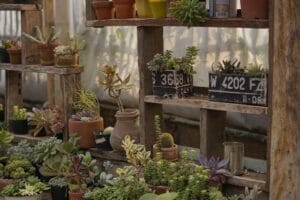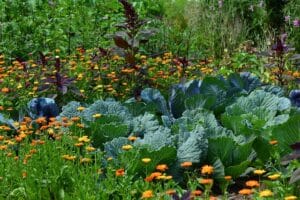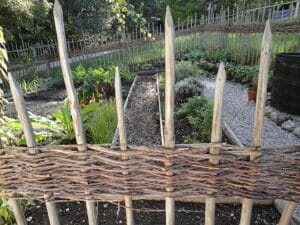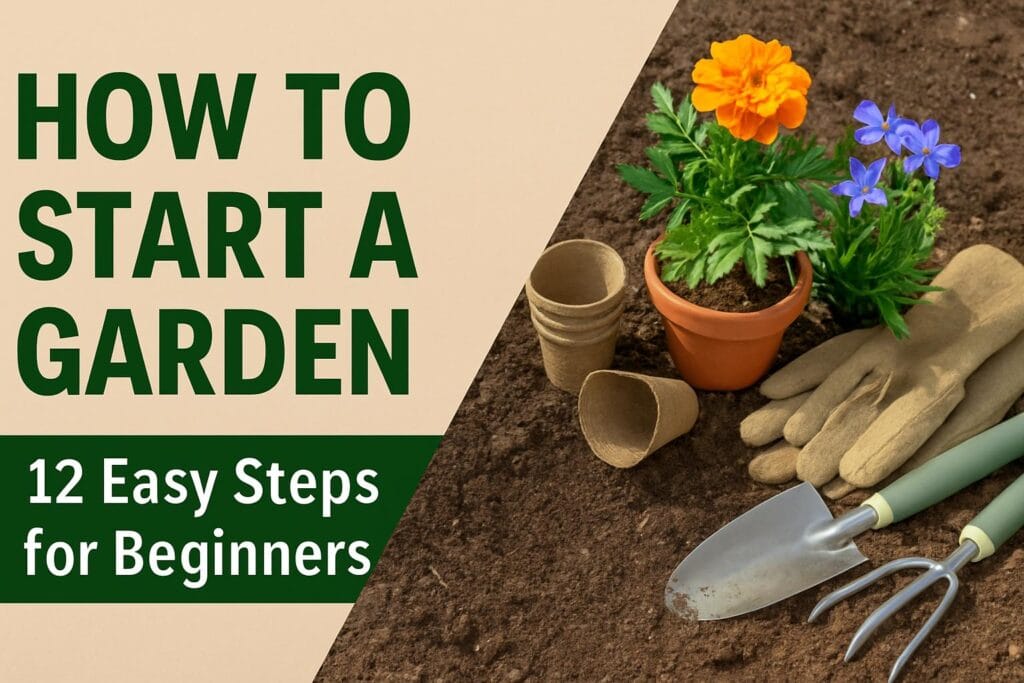How to Start a Garden: 12 Easy Steps for Beginners
Are you dreaming of fresh flowers, homegrown vegetables, or a lush green space to relax? Starting a garden is one of the most rewarding hobbies you can enjoy. Whether you have a spacious backyard or just a small balcony, gardening can bring beauty, health benefits, and satisfaction into your life. If you’re a beginner and wondering how to start a garden, don’t worry—we’ve got you covered! This step-by-step guide will take you through everything you need to know to create a thriving garden from scratch.
In this article, you’ll learn the 12 simple steps to start a garden, helpful tips for beginners, and common mistakes to avoid. Let’s get planting!
| Aspect | Beginner Tips |
| Best Plants | Tomatoes, lettuce, basil, marigolds, zinnias |
| Tools Needed | Trowel, gloves, watering can, pruners, rake |
| Soil Type | Well-draining, enriched with compost |
| Sunlight | 6-8 hours daily |
| Watering | Deep watering, 2-3 times per week |
| Harvest Time | Depending on plant—usually 30-90 days |
1. Decide What Type of Garden You Want
The first step in starting a garden is deciding what you want to grow. Different types of gardens serve different purposes:
- Vegetable Garden: Grow fresh, organic vegetables for your kitchen.
- Herb Garden: Perfect for culinary herbs like basil, mint, or rosemary.
- Flower Garden: Add beauty and color to your outdoor space.
- Indoor Garden: Small indoor plants for apartments or homes without a yard.
- Pollinator Garden: Attract bees and butterflies with nectar-rich flowers.
Pro Tip: Start small. You can always expand later once you gain confidence and experience.

2. Choose the Right Location
Your garden’s success depends heavily on its location. Here’s what you should consider:
- Sunlight: Most vegetables and flowers need 6-8 hours of direct sunlight daily.
- Soil Quality: Choose an area with well-draining, nutrient-rich soil.
- Water Access: Ensure your garden is close to a water source.
- Space: Consider the available space and select plants accordingly.
For beginners, a sunny spot with easy access to water makes gardening much simpler.
3. Plan Your Garden Layout
Planning your garden layout helps you make the most of your space. Sketch a simple design or use online garden planners. Some popular layouts include:
- Rows: Best for vegetable gardens.
- Raised Beds: Easy to maintain and perfect for limited spaces.
- Container Gardening: Ideal for balconies or patios.
- Square Foot Gardening: Great for beginners to maximize small areas.
Tip: Group plants with similar sunlight and water needs together.
4. Test and Prepare Your Soil
Healthy soil = healthy plants. Here’s how to get your soil ready:
- Test the Soil: Use a simple soil test kit to check pH and nutrients.
- Amend the Soil: Add compost, organic matter, or other soil amendments based on your soil test results.
- Loosen the Soil: Till or turn the soil to a depth of 8-12 inches.
Good soil preparation sets the foundation for a productive garden.

5. Choose Beginner-Friendly Plants
For your first garden, choose plants that are easy to grow and forgiving of beginner mistakes:
- Vegetables: Tomatoes, radishes, lettuce, cucumbers, zucchini.
- Herbs: Basil, mint, parsley, oregano.
- Flowers: Marigolds, sunflowers, zinnias, petunias.
- Indoor Plants: Spider plant, pothos, peace lily.
Select plants suitable for your climate and growing zone. You can use the USDA Hardiness Zone map to guide your choices.
6. Gather Essential Gardening Tools
Every gardener needs a few basic tools to get started. Here’s a list of must-haves:
- Trowel: For digging small holes and planting.
- Hand Rake: Great for loosening soil and removing weeds.
- Garden Gloves: Protects your hands from thorns and dirt.
- Watering Can or Hose: To keep your plants hydrated.
- Pruning Shears: For trimming and maintaining plants.
- Garden Fork or Shovel: For turning soil and larger planting jobs.
Invest in good quality tools—they will last longer and make gardening easier.
7. Plant at the Right Time
Timing is crucial for planting success. Follow these guidelines:
- Check Frost Dates: Know your area’s last frost date in spring and first frost date in fall.
- Start Indoors or Direct Sow: Some seeds can be started indoors, while others should be planted directly in the garden.
- Follow the instructions on seed packets or plant tags for planting depth, spacing, and timing.
Tip: Keep a gardening calendar to remind yourself of key planting dates.

8. Water Correctly
Watering properly helps plants thrive without wasting water:
- Consistency: Most plants prefer even, consistent moisture—not too dry or too soggy.
- Morning Watering: Water in the early morning to prevent diseases and evaporation.
- Deep Watering: Water deeply so roots grow strong and healthy.
Avoid frequent shallow watering, which encourages weak roots.
9. Mulch to Keep Soil Healthy
Mulching offers multiple benefits:
- Prevents Weeds: Reduces weed growth by blocking sunlight.
- Retains Moisture: Keeps soil moist longer.
- Regulates Temperature: Protects roots from extreme heat or cold.
- Improves Soil Quality: Organic mulches break down and enrich the soil.
Use natural materials like straw, wood chips, leaves, or grass clippings around your plants.
10. Maintain Your Garden Regularly
A thriving garden needs regular care:
- Weeding: Pull weeds weekly to prevent competition for nutrients.
- Pruning: Trim dead or overgrown branches to promote healthy growth.
- Feeding: Add organic fertilizers or compost every few weeks.
- Pest Control: Check plants regularly for signs of pests or diseases.
Consistency is key—spending 10-15 minutes a day in your garden can make a huge difference.
11. Harvest Your Crops
Harvesting at the right time ensures the best flavor and quality:
- Vegetables: Pick when ripe—overripe veggies can be tough or bitter.
- Herbs: Regular harvesting promotes bushier growth.
- Flowers: Cut flowers in the morning when they are freshest.
- Indoor Plants: Rotate and clean leaves regularly for healthy indoor plants.
Enjoy your harvest fresh or preserve it by drying, freezing, or canning.

12. Keep Learning and Experimenting
Gardening is a lifelong learning journey. You’ll discover new plants, methods, and tricks every season. Don’t be afraid to:
- Try different plants each year.
- Experiment with organic gardening techniques.
- Join local gardening groups or online communities.
- Take notes on what works and what doesn’t.
Even experienced gardeners make mistakes—so be patient and enjoy the process.
Common Mistakes to Avoid When Starting a Garden
Before you grab your shovel, here are some common mistakes beginners should avoid:
Planting too much too soon—start small!
Ignoring plant spacing—overcrowded plants won’t grow well.
Overwatering or underwatering—always check soil moisture.
Choosing the wrong plants for your zone—check your local climate.
Forgetting to feed your plants—soil nutrients run out over time.
Avoiding these mistakes will save you time, money, and frustration.
Benefits of Gardening for Beginners
If you’re wondering why gardening is worth it, here are just a few benefits:
Fresh Food: Grow your vegetables and herbs—healthier and tastier!
Physical Activity: Gardening is a great way to stay active and fit.
Mental Health: Studies have shown that gardening reduces stress and improves mood.
Sustainability: Reduce your carbon footprint by growing your produce.
Creativity: Express yourself through garden design and plant choices.
FAQs About Starting a Garden
Q1: What is the easiest vegetable to grow for beginners?
Answer: Radishes, lettuce, and tomatoes are among the easiest vegetables for beginners.
Q2: How much time does gardening take daily?
Answer: 10-15 minutes a day for small gardens, or 1-2 hours weekly, is sufficient for maintenance.
Q3: Can I start a garden without a backyard?
Answer: Absolutely! Container gardening on balconies or indoor gardening is are great alternative.
Q4: Do I need special fertilizers?
Answer: For beginners, compost or an all-purpose organic fertilizer is enough to start.
Q5: How can I prevent pests naturally?
Answer: Use neem oil, companion planting (like marigolds), and natural predators like ladybugs.
Final Thoughts
Starting a garden is easier than you might think. With these 12 simple steps, you’ll be well on your way to enjoying fresh produce, beautiful flowers, and a peaceful green space. Remember to start small, choose easy plants, and enjoy the learning process. Gardening is not just about plants—it’s about growing happiness, health, and a connection with nature.
Ready to dig in? Start your garden today and enjoy the rewards all season long!

